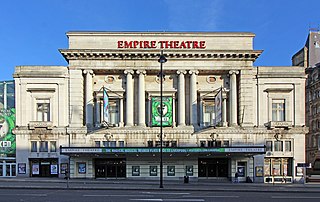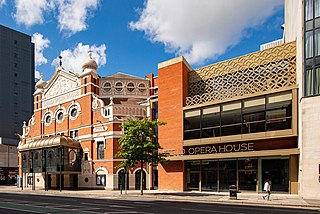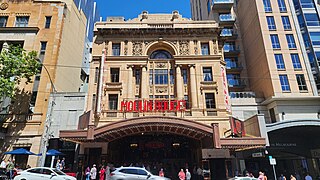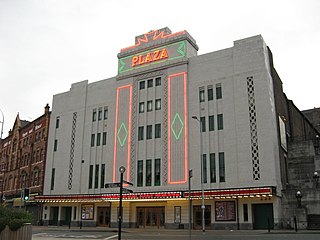
The Empire, Leicester Square is a cinema currently operated by Cineworld on the north side of Leicester Square, London, United Kingdom.

The Royal Court Theatre is a theatre located at 1 Roe Street in Liverpool, England. The current Royal Court Theatre was opened on 17 October 1938, after fire destroyed its predecessor. It was rebuilt in Art Deco style and soon became Liverpool's premier theatre. The interior of the building has a nautical theme, in line with Liverpool's seafaring traditions. The design of the basement lounge was based on the Cunard liner Queen Mary until its conversion into the Studio space during renovations. There are three viewing levels within the main auditorium: the Stalls, the Grand Circle and the Balcony.

The Liverpool Empire Theatre is a theatre on the corner of Lime Street in Liverpool, England. The playhouse, which opened in 1925, is the second one to be built on the site. It has the largest two-tier auditorium in the United Kingdom and can seat 2,348 people.

The Sunderland Empire Theatre is a large theatre venue located in High Street West in Sunderland, North East England. The theatre, which opened in 1907, is owned by City of Sunderland Council and operated by Ambassador Theatre Group Ltd, on behalf of Sunderland Empire Theatre Trust.

The Birmingham Hippodrome is a theatre situated on Hurst Street in the Chinese Quarter of Birmingham, England.

The Rex is a cinema in the town of Berkhamsted, Hertfordshire, England. Designed in the art deco style by David Evelyn Nye in 1936, the cinema opened to the public in 1938. After 50 years of service, the cinema closed in 1988 and became derelict. The building was listed Grade II by English Heritage, and following a campaign to save the Rex by a local entrepreneur, the cinema re-opened to the public in 2004.

The New Wimbledon Theatre is situated on the Broadway, Wimbledon, London, in the London Borough of Merton. It is a Grade II listed Edwardian theatre built by the theatre lover and entrepreneur, J. B. Mulholland, who at the time was also owner of the King's Theatre in Hammersmith and had owned the Theatre Metropole in Camberwell in the 1890's. Built on the site of a large house with spacious grounds, the theatre was designed by Cecil Aubrey Massey and Roy Young. It seems to have been the only British theatre to have included a Victorian-style Turkish bath in the basement. The theatre opened on 26 December 1910 with the pantomime Jack and Jill.

The Capitol is an historic Australian theatre on Swanston Street in the central business district (CBD) of Melbourne, Victoria. Opened in 1924 as part of the Capitol House building, the art deco theatre was designed by American husband and wife architects Walter Burley Griffin and Marion Mahony Griffin. It is the oldest of Melbourne's large picture palaces and is known for its extravagant decor and abstract motifs, including an intricate geometric ceiling containing thousands of coloured lamps designed to evoke the walls of a crystalline cave.

The Grand Opera House is a theatre in Belfast, Northern Ireland, designed by the most prolific theatre architect of the period, Frank Matcham. It opened on 23 December 1895. According to the Theatres Trust, the "magnificent auditorium is probably the best surviving example in the United Kingdom of the oriental style applied to theatre architecture". The auditorium was restored to its former glory, and the foyer spaces and bars were reimagined and developed as part of a £12.2 million project in 2020/2021, generously supported by the National Lottery Heritage Fund. [1]

The Victoria Theatre is a heritage-listed former theatre at 8–10 Perkins Street, Newcastle, City of Newcastle, New South Wales, Australia. It was opened in 1876 and rebuilt during 1890–1891, and is the oldest theatre still standing in New South Wales. It was added to the New South Wales State Heritage Register on 27 August 1999.

His Majesty's Theatre is an Edwardian Baroque theatre in Perth, Western Australia. Constructed from 1902 to 1904 during a period of great growth for the town, the theatre is located on the corner of Hay Street and King Street in Perth's central business district.

The Theatre Royal, was an opera house and performance venue in Wexford Ireland which opened in 1832 and closed in 2005. It was the home of the annual Wexford Festival Opera, and has now been replaced by The National Opera House.

The Regent Theatre is a theatre in Stoke-on-Trent, England. Constructed in 1929 as a cinema, it is one of several theatres in the city centre and one of two operated by the Ambassador Theatre Group on behalf of Stoke-on-Trent City Council. The building was converted for full-time use as a theatre in 1999, and since then has hosted a number of shows and musicals. The theatre is also the northern base for the Glyndebourne Touring Opera.

The Assembly Hall Theatre is a theatre in Tunbridge Wells seating 1,020 people. The theatre hosts a variety of popular music, comedy, family, dance, drama, classical music and variety events, as well as an annual pantomime.

Chitty Chitty Bang Bang is a musical with music and lyrics written by Richard and Robert Sherman and a book by Jeremy Sams. It is sometimes referred to as Chitty the Musical to distinguish it from the 1968 film of the same name on which it is based, written by Roald Dahl, Ken Hughes, and Richard Maibaum. The 1968 film was based in turn on the book of the same name by Ian Fleming. The show premiered at the London Palladium on April 16, 2002, directed by Adrian Noble before opening on Broadway in 2005.

The Regent Theatre is an historic former picture palace built in 1929, closed in 1970, and restored and reopened in 1996 as a live theatre in Collins Street, in the city of Melbourne, Australia. It is one of six city theatres collectively known as Melbourne's East End Theatre District. Designed by Charles Ballantyne in an ornately palatial style, with a Gothic style lobby, Louis XVI style auditorium, and the Spanish Baroque style Plaza Ballroom in the basement, it is listed by the National Trust of Australia and is on the Victorian Heritage Register.

Canberra Theatre Centre (CTC), also known as the Canberra Theatre, is the Australian Capital Territory’s central performing arts venue and Australia's first performing arts centre, the first Australian Government initiated performing arts centre to be completed. It opened on 24 June 1965 with a gala performance by the Australian Ballet.

Bridlington Spa is a dance hall, theatre and conference centre in Bridlington, East Riding of Yorkshire, England. Refurbished between 2006 and 2008 and further updated with a new branding in 2016, the venue boasts a large Art Deco ball room, Edwardian theatre, art gallery and a selection of other meeting and event spaces; all featuring outstanding views over Bridlington's South Bay.

The Plaza is a Grade II* listed art deco single-screen cinema and theatre in Stockport, Greater Manchester, England. It opened in 1932, its construction having involved the excavation of the sandstone cliff behind it. After an initial closure in 1966 and a subsequent period in use as a bingo hall by Rank Leiure, it has now been restored as a cinema and theatre, showing films and staging live shows.

The Marina is a theatre and cinema in Lowestoft, Suffolk, originally opened in the Victorian era. The venue has an auditorium seating 800. It plays host to major West End productions, top comedy, orchestral concerts, touring drama and musical productions, opera, ballet, music, dance and celebrity concerts as well as operating a successful cinema operation - boasting the largest screen and cinema auditoria in the town. The Marina annually hosts the largest professional pantomime on the East Anglian Coast.






















